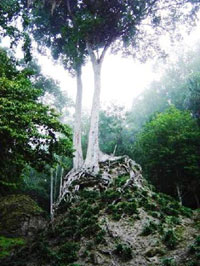A good news story from New Scientist magazine, 27 May 2006

Two thousand years ago, the Mayans planted millions of nut trees in their central American rainforests and it became their staple food. Today the trees are chopped down to make room for fields of corn that produce far less food.
Just over five years ago a visiting doctor discovered the true worth of the Maya nut while working as a biologist in Guatemala. Erika Vohman, from The Equilibrium Fund, initially worked with the UN Development Programme saving traditional crops and helping Guatemalan communities become more independent.
Her first project was for a village called La Benedicion. The people were economic refugees but had recently been given land under Guatemala’s land reform program. When Erika arrived the people hadn’t started planting crops. In fact they had no houses and were hungry.
Erika taught the women about the Maya nut and that’s what the community lived on for the next three months. Today, all the families in that village collect the nuts for their daily diet and for sale. They have planted new trees too.
A grant from the Global Environment Fund allowed the village to train other villages about the Maya nut.
‘I reckon we have trained 400 to 500 villages now, maybe more; villages now train each other, so it’s hard to keep track,’ says Erika Vohman. ‘The women are thunderstruck to discover they can eat stuff that they have always just walked over.’

The curious aspect is how knowledge of the nut was lost. Erika explains that in some places it was remembered only as famine food and there are old stories about how Mexican outsiders introduced corn and the locals simply stopped eating the nut.
The Maya nut tree is the largest tree in the rainforest, growing up to 45 metres tall. The nuts are eaten dried as they are, or are ground into flour. In some areas, the locals are making and selling Maya nut products like cookies.
Erika Vohman now goes wherever there is extreme poverty and Maya nut trees. Unfortunately, logging and farming now means that the remaining trees are in remote areas. She is now campaigning to make the Maya nut tree a protected species, which should happen in Nicaragua by November.
‘It is hard for some people to imagine that a large tree growing in the wild is cultivated. But that is way the May nut tree is: an ancient cultivated crop.’ Erika says. ‘Hopefully, we have rediscovered it just in time.’
Erika Vohman’s work on the Maya nut was for the Equilibrium Fund. It recently won the prestigious St Andrews Prize for the Environment, which earned the Fund $50,000. The money is to be spent on new programs in Bosawas, Mosquitia Nicaragua, the Rio San Juan Biosphere Reserve on the border of Nicaragua and Costa Rica, and Montes Azules Biosphere Reserve in Chiapas, Mexico. All threatened regions with high densities of Maya Nut trees.
More Information (courtesy of Wikipedia, wikipedia.org/wiki/Brosimum_alicastrum)
Family: Moraceae (mulberry Family)
Botanic Name: Brosimum alicastrum
Common Names: Maya nut tree, also called ramon, ojoche, ujuxte or masica.
Maya Nut is extremely high in fibre, calcium, potassium, folic acid, iron, zinc, protein and vitamins A, E, C and B. The fresh seeds can be cooked and eaten or can be set out to dry in the sun to roast and eat later. Stewed the nut tastes like mashed potato, roasted it tastes like chocolate or coffee and can be prepared in numerous other dishes.
No information on growing the nut in Australia was found via web search, but if it were it would only suit tropical climates. If anyone has any experience or further information, please let SGA know.
All photos courtesy of the Equilibrium Fund website.
Related Articles:
Garden Journaling – Slow down to tune in.
As we move through the year and our gardens evolve, there's something magical about documenting the journey. Garden journaling is an art that enables…
The Importance of building soil health for a biodeverse, productive garden
Creating a thriving garden that not only sustains itself but also contributes to the broader ecosystem requires more than just sunlight and water.…




